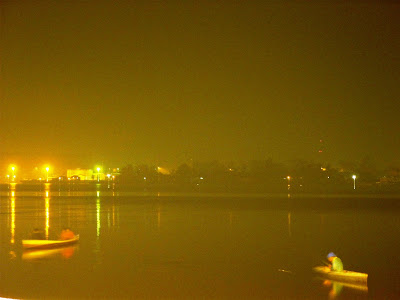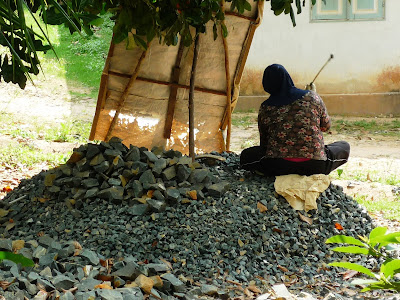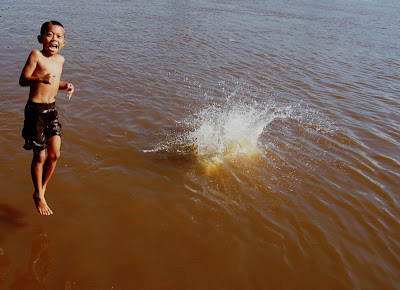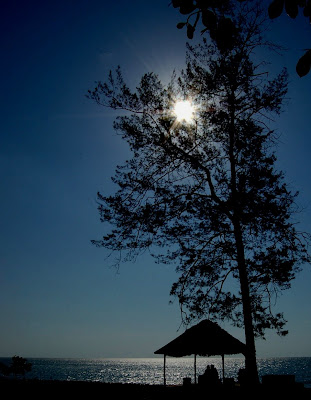
Bagan or termal is a small hut on the sea built to trap fishes and squids during the night. I always amaze on how the fishermen are able to build bagan in the 3-8 meters deep sea. First, they make the stake frames from bamboo in the village. Then they bring the frames to the sea with boats and embed them in to 3-8 meters deep seabed. Interlace between the frames makes it stable. It cost about 2-5 million IDR to construct a bagan and usually it can hold out for 1-2 years if not swept by big wave storm beforehand.
Soon before nightfall, the fishermen will paddle their boat leaving for bagan. On bagan, they scroll down the net into water, lit on
petromaks, kind of lantern, and hang it under the hut, just before the sea level. The light from
petromaks will attract fish and squid to gather under it, just above the net. Then the waiting part is began. It could stand from 10 minutes till hours, depend on how much fish and squid gathered above the net.
Each bagan need at least 2 persons to operate. When it's enough fish or squid gathered above the net, one person will roll up the net, the other will standby in the hut to pull up
petromaks and then to catch the fish and or squid with a smaller scoop net with long handle from the net under.
 I know 3 places in Indonesia called Ketapang. First is Ketapang in Banyuwangi, East Java, which is well known for its port used to cross to Gilimanuk, Bali. The next is Ketapang in West Kalimantan, a district on the south of West Kalimantan. The last one is Ketapang in Sampang, Madura. My travel to Sampang last September completed my visits to all 3 Ketapangs in Indonesia.
I know 3 places in Indonesia called Ketapang. First is Ketapang in Banyuwangi, East Java, which is well known for its port used to cross to Gilimanuk, Bali. The next is Ketapang in West Kalimantan, a district on the south of West Kalimantan. The last one is Ketapang in Sampang, Madura. My travel to Sampang last September completed my visits to all 3 Ketapangs in Indonesia.









 Bagan or termal is a small hut on the sea built to trap fishes and squids during the night. I always amaze on how the fishermen are able to build bagan in the 3-8 meters deep sea. First, they make the stake frames from bamboo in the village. Then they bring the frames to the sea with boats and embed them in to 3-8 meters deep seabed. Interlace between the frames makes it stable. It cost about 2-5 million IDR to construct a bagan and usually it can hold out for 1-2 years if not swept by big wave storm beforehand.
Bagan or termal is a small hut on the sea built to trap fishes and squids during the night. I always amaze on how the fishermen are able to build bagan in the 3-8 meters deep sea. First, they make the stake frames from bamboo in the village. Then they bring the frames to the sea with boats and embed them in to 3-8 meters deep seabed. Interlace between the frames makes it stable. It cost about 2-5 million IDR to construct a bagan and usually it can hold out for 1-2 years if not swept by big wave storm beforehand.







 aah..Pontianak during the dry season
aah..Pontianak during the dry season






 there's never a same sunset. The sunset in Tomajo island is one of the most beautiful and heartwarming sunset I ever saw. Seeing the single coconut tree shadow standing on the island hillside (too small to be seen in this picture) gave me some kind of lonely but peaceful feeling.
there's never a same sunset. The sunset in Tomajo island is one of the most beautiful and heartwarming sunset I ever saw. Seeing the single coconut tree shadow standing on the island hillside (too small to be seen in this picture) gave me some kind of lonely but peaceful feeling.

 A friend of mine said that this looks like a common government project, built with low quality materials after corrupted here and there and at the end doesn't serve the early planned function because of the improper execution or wrong target. I can't agree more, development projects in my beloved country still need lots of improvement.
A friend of mine said that this looks like a common government project, built with low quality materials after corrupted here and there and at the end doesn't serve the early planned function because of the improper execution or wrong target. I can't agree more, development projects in my beloved country still need lots of improvement.



















